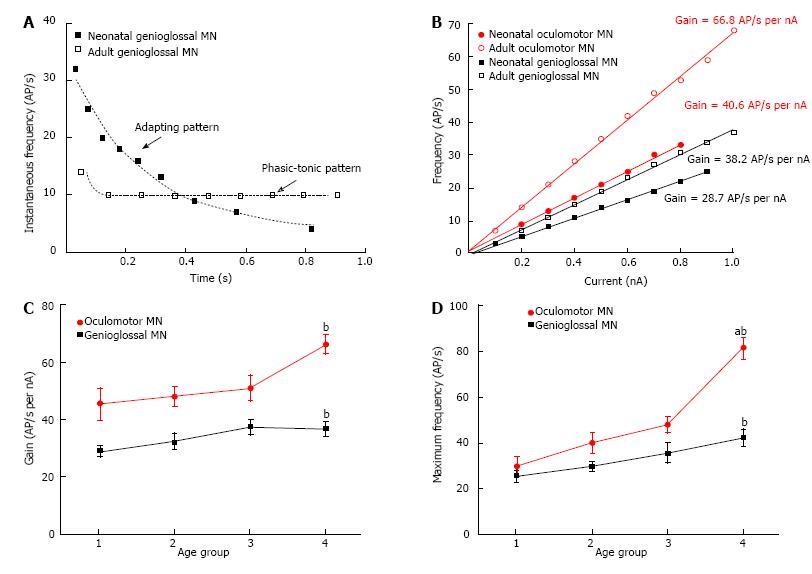Copyright
©The Author(s) 2015.
World J Neurol. Dec 28, 2015; 5(4): 113-131
Published online Dec 28, 2015. doi: 10.5316/wjn.v5.i4.113
Published online Dec 28, 2015. doi: 10.5316/wjn.v5.i4.113
Figure 6 Postnatal maturation of repetitive firing properties of motoneurons from genioglossal and oculomotor nuclei.
A: Instantaneous firing frequency evoked by depolarizing current stimulus of 0.3 nA for a representative MN from the GG nucleus. Only the neonatal MN shows an adapting firing pattern while the adult MN shows a phasic-tonic pattern; B: Relationship between current (I) and firing (F) for a representative neonatal MN (filled red circle) and an adult OCM MN (open red circle); and for a representative neonatal MN (filled black square) and an adult MN (open black square). The slope of the I-F relationship is the gain; C, D: Plots illustrating the changes on gain (C) and maximum firing frequency (D) during postnatal development for GG and OCM MNs. Note that gain and maximun firing frequency increase with age, although these increments are larger for OCM MNs. The "a" indicates statistical significance between two consecutive age groups; and the "b" represents statistical significance between age group 1 and age group 4. The age groups 1,2,3 and 4 correspond to P1-P5, P6-P10, P11-P15 and P21-P30, respectively. The data from GG[4] and OCM[10] come from previous studies. MNs: Motoneurons; GG: Genioglossal; OCM: Oculomotor.
- Citation: Carrascal L, Nieto-González J, Pardillo-Díaz R, Pásaro R, Barrionuevo G, Torres B, Cameron WE, Núñez-Abades P. Time windows for postnatal changes in morphology and membrane excitability of genioglossal and oculomotor motoneurons. World J Neurol 2015; 5(4): 113-131
- URL: https://www.wjgnet.com/2218-6212/full/v5/i4/113.htm
- DOI: https://dx.doi.org/10.5316/wjn.v5.i4.113









